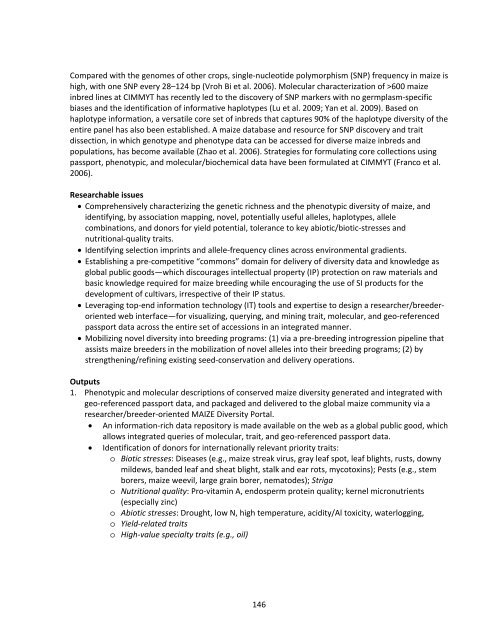Download - Maize
Download - Maize
Download - Maize
Create successful ePaper yourself
Turn your PDF publications into a flip-book with our unique Google optimized e-Paper software.
Compared with the genomes of other crops, single‐nucleotide polymorphism (SNP) frequency in maize is<br />
high, with one SNP every 28–124 bp (Vroh Bi et al. 2006). Molecular characterization of >600 maize<br />
inbred lines at CIMMYT has recently led to the discovery of SNP markers with no germplasm‐specific<br />
biases and the identification of informative haplotypes (Lu et al. 2009; Yan et al. 2009). Based on<br />
haplotype information, a versatile core set of inbreds that captures 90% of the haplotype diversity of the<br />
entire panel has also been established. A maize database and resource for SNP discovery and trait<br />
dissection, in which genotype and phenotype data can be accessed for diverse maize inbreds and<br />
populations, has become available (Zhao et al. 2006). Strategies for formulating core collections using<br />
passport, phenotypic, and molecular/biochemical data have been formulated at CIMMYT (Franco et al.<br />
2006).<br />
Researchable issues<br />
Comprehensively characterizing the genetic richness and the phenotypic diversity of maize, and<br />
identifying, by association mapping, novel, potentially useful alleles, haplotypes, allele<br />
combinations, and donors for yield potential, tolerance to key abiotic/biotic‐stresses and<br />
nutritional‐quality traits.<br />
Identifying selection imprints and allele‐frequency clines across environmental gradients.<br />
Establishing a pre‐competitive “commons” domain for delivery of diversity data and knowledge as<br />
global public goods—which discourages intellectual property (IP) protection on raw materials and<br />
basic knowledge required for maize breeding while encouraging the use of SI products for the<br />
development of cultivars, irrespective of their IP status.<br />
Leveraging top‐end information technology (IT) tools and expertise to design a researcher/breederoriented<br />
web interface—for visualizing, querying, and mining trait, molecular, and geo‐referenced<br />
passport data across the entire set of accessions in an integrated manner.<br />
Mobilizing novel diversity into breeding programs: (1) via a pre‐breeding introgression pipeline that<br />
assists maize breeders in the mobilization of novel alleles into their breeding programs; (2) by<br />
strengthening/refining existing seed‐conservation and delivery operations.<br />
Outputs<br />
1. Phenotypic and molecular descriptions of conserved maize diversity generated and integrated with<br />
geo‐referenced passport data, and packaged and delivered to the global maize community via a<br />
researcher/breeder‐oriented MAIZE Diversity Portal.<br />
An information‐rich data repository is made available on the web as a global public good, which<br />
allows integrated queries of molecular, trait, and geo‐referenced passport data.<br />
Identification of donors for internationally relevant priority traits:<br />
o Biotic stresses: Diseases (e.g., maize streak virus, gray leaf spot, leaf blights, rusts, downy<br />
mildews, banded leaf and sheat blight, stalk and ear rots, mycotoxins); Pests (e.g., stem<br />
borers, maize weevil, large grain borer, nematodes); Striga<br />
o Nutritional quality: Pro‐vitamin A, endosperm protein quality; kernel micronutrients<br />
(especially zinc)<br />
o Abiotic stresses: Drought, low N, high temperature, acidity/Al toxicity, waterlogging,<br />
o Yield‐related traits<br />
o High‐value specialty traits (e.g., oil)<br />
146

















